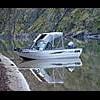Regarding Timbrens once more: Watch the video here and you'll see clearly that they only engage once the vehicle is loaded and the suspension has already sagged. They might keep the rear suspension from actually bottoming out under a load, but they do nothing to maintain a proper and safe ride height.
Rookie tire and rear suspension questions
#22

Posted 09 May 2018 - 06:44 PM
I wish it was possible to have a test bed to confirm all the information floating around for all truck/camper combinations, but that's impossible. Still, this would be a perfect design I think:
A set of scales with digital readouts and a proper computer to handle the information...
1) First, enter the VIN tag maximums for Front, Rear and Gross Vehicle Ratings as your baseline
2) Drive onto the scale with full tanks of fuel and nothing else to establish all three ACTUAL readings
3) Load up the camper, add all the "stuff" and passengers and drive onto the scale again for all three readings
4) Now you know the total weight of the "stuff"
5) Now you know the weight on the Front and Rear axels and if the Rear is overloaded and by how much.
This is the point you have to face in upgrading the truck if in fact you are seriously overweight on the rear axel.
It is also time to check the VIN to see what tire your truck is RATED for at the acceptable weights for Front & Rear axels.
If you are within spec, then just purchase the tires you prefer with that rating as per your usage.
However....if you are over weight on that rear axel and have added suspension/spring/bag elements in an attempt to level the ride (I think that translates to carry the load), then you should consider upgrading the tires as a part of your attempt to carry the load better. If you are already at spec with a load range E tire, then you are hitting the ceiling if the truck has serious suspension/spring/bag upgrades to it.
I think the key here is simple....if you are just at or just above the weight rating of either axle (forget the combined weight rating for a moment here!) you may not need to upgrade anything....but....if your truck is sagging at the rear then you should upgrade things!
My '88 F-250 VIN says the GVWR is 8800, the Front GAWR is 3920 and the Rear GAWR is 6084.
When weighed full of gas the GVWR was 6400, the Front was 3520 and the Rear GAWR was 2860.
My '76 Alaskan 8' CO tag from Sun Valley says it weighs 1450 with 20 gal h2o and 25 lbs of ice.
Now...I haven't weighed it with the camper loaded into it yet, but when I put the camper into the truck, I think it just sat down an inch or two and in comparing the numbers above I am far from being even CLOSE to overloading the rear axle. I measured how the truck sits and it is just about LEVEL with the camper on it, meaning the truck just sat down about equally with it in there.
The VIN called for LT235/85R 16 tires and that's what I have on it...I did notice the truck sits down smoother on the freeway at about 55-65 than when empty of course and the ride is smoother as well. Seems to be a perfect combination.
I think it is a result of a truck that can handle the load within spec and with the correct tires on it. I have some Michelins X Radial XTs I am getting ready to replace due to old age.
It is too bad you can't figure out what all you will be carrying and how much weight that camper and "stuff" will eventually weight and how much is distributed to the Front and the Rear axels...if you knew that, you could probably tell if you have "enough truck" or if some suspension/springs/bags will alleviate that and level the truck. You could compare the VIN maximums with that information to know if even with some additions if you will be SAFE.
I suspect that some alterations to the truck may make the truck LEVEL but still leave you WAY overloaded on that rear axel!
Bottom line I think is to check with owners of trucks EXACTLY like yours (engine/bed length/cab size/4x4?) and those who have a camper EXACTLY like yours to see what they did and what range tires they use and tread types.
1988 Ford F-250 HD Lariat 4x4 8 Ft. bed
1976 Alaskan 8 Ft. CO camper
#23

Posted 09 May 2018 - 10:37 PM
ok another suspension handling question ?
has any one ran a hellwig sway bar?
i am currently building a new rig and have read about these.
i am aways off on finishing the new rig,the old f-150 and popup will have to work in baja this winter.
so anybody running a hellwig,thoughts opinions
thanks
kp
#24

Posted 10 May 2018 - 03:27 AM
I added a Hellwig sway bar to my 2010 Tundra a month prior to installing my new Hawk. It made a great difference in handling stability especially in curvy mountain roads. The other change that helped was E series tires. I have essentially no body sway with these changes and the Hawk mounted.. Would do both again.ok another suspension handling question ?
has any one ran a hellwig sway bar?
i am currently building a new rig and have read about these.
i am aways off on finishing the new rig,the old f-150 and popup will have to work in baja this winter.
so anybody running a hellwig,thoughts opinions
thanks
kp
Paul
#25

Posted 11 May 2018 - 04:48 PM
Thanks everyone! This has been very helpful. I've decided to go ahead with the cooper backcountry AT e load rated tires.
Also tagged with one or more of these keywords: Frontier, Eagle, tires, suspension
0 user(s) are reading this topic
0 members, 0 guests, 0 anonymous users


















